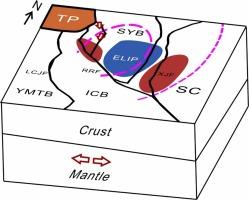高密度地震阵列的瑞利相速度和方位各向异性揭示了块体边界断层对中国西南部地壳物质迁移的强烈控制作用
IF 2.7
3区 地球科学
Q2 GEOSCIENCES, MULTIDISCIPLINARY
引用次数: 0
摘要
四川-云南块体南部位于中国西南部青藏高原东南缘,与西北走向的红河断层和近NS走向的小江断层等边界断层相交。这是探索严重地壳变形和复杂构造运动的关键地带。利用 SYB 南部多个临时地震台阵和区域永久地震台的环境噪声数据,我们可以通过直接反演方法获得高分辨率 S 波速度和方位各向异性。然而,瑞利相速度可以揭示不同时期特定厚度范围的构造特征。为了评估直接反演法在正演计算中的可靠性,本研究进一步计算了 5-40 s 周期的瑞利相速度和方位各向异性。与 S 波速度和方位各向异性相比,正演瑞利相速度和方位各向异性显示了相似的规律。与传统获得的瑞利相速度和方位各向异性相比,前向结果显示出良好的一致性,由于地震台站密集,提供了更多低速异常和方位各向异性的细节。与以往结果明显不同的是,XJF下方的低速异常没有穿过RRF南段,导致沿断层分布的力学弱地壳物质呈现快轴局部复合形态。这可能表明RRF对深部构造有很强的控制作用。本文章由计算机程序翻译,如有差异,请以英文原文为准。

Rayleigh phase velocity and azimuthal anisotropy from high dense seismic arrays reveal strong control of block boundary faults on crustal material migration in SW China
Located on the southeastern margin of the Tibetan plateau (TP), SW China, the southern Sichuan-Yunnan block (SYB) is intersected by boundary faults as the NW-trending Red River fault (RRF) and the nearly NS-trending Xiaojiang fault (XJF). It is a crucial zone for exploring severe crustal deformation and complicated tectonic movement. Using ambient noise data from multiple temporary seismic arrays and regional permanent seismic stations within the southern SYB, we can obtain the high-resolution S-wave velocity and azimuthal anisotropy by the direct inversion method. However, the Rayleigh phase velocity can reveal the structural characteristics of specific range of thickness at various periods. To evaluate the reliability of the direct inversion method in forward calculation, this study further calculates the Rayleigh phase velocity and azimuthal anisotropy at periods of 5–40 s. Compared with the S-wave velocity and azimuthal anisotropy, the forward Rayleigh phase velocity and azimuthal anisotropy illustrate similar patterns. Compared with the traditionally obtained Rayleigh phase velocity and azimuthal anisotropy, the forward results show good consistency, providing more details of the low-velocity anomalies and the azimuthal anisotropy owing to the dense seismic stations. A notable difference from previous results is that the low-velocity anomaly beneath the XJF does not cross over the southern segment of the RRF, resulting in the mechanically weak crustal materials distributed along the faults showing the fast axis of local complex pattern. This may indicate that the RRF strongly controls the deep structures.
求助全文
通过发布文献求助,成功后即可免费获取论文全文。
去求助
来源期刊

Journal of Asian Earth Sciences
地学-地球科学综合
CiteScore
5.90
自引率
10.00%
发文量
324
审稿时长
71 days
期刊介绍:
Journal of Asian Earth Sciences has an open access mirror journal Journal of Asian Earth Sciences: X, sharing the same aims and scope, editorial team, submission system and rigorous peer review.
The Journal of Asian Earth Sciences is an international interdisciplinary journal devoted to all aspects of research related to the solid Earth Sciences of Asia. The Journal publishes high quality, peer-reviewed scientific papers on the regional geology, tectonics, geochemistry and geophysics of Asia. It will be devoted primarily to research papers but short communications relating to new developments of broad interest, reviews and book reviews will also be included. Papers must have international appeal and should present work of more than local significance.
The scope includes deep processes of the Asian continent and its adjacent oceans; seismology and earthquakes; orogeny, magmatism, metamorphism and volcanism; growth, deformation and destruction of the Asian crust; crust-mantle interaction; evolution of life (early life, biostratigraphy, biogeography and mass-extinction); fluids, fluxes and reservoirs of mineral and energy resources; surface processes (weathering, erosion, transport and deposition of sediments) and resulting geomorphology; and the response of the Earth to global climate change as viewed within the Asian continent and surrounding oceans.
 求助内容:
求助内容: 应助结果提醒方式:
应助结果提醒方式:


